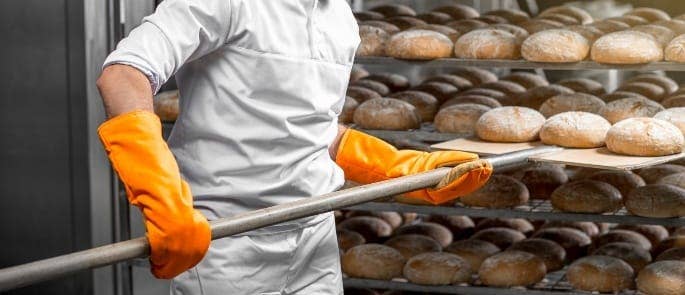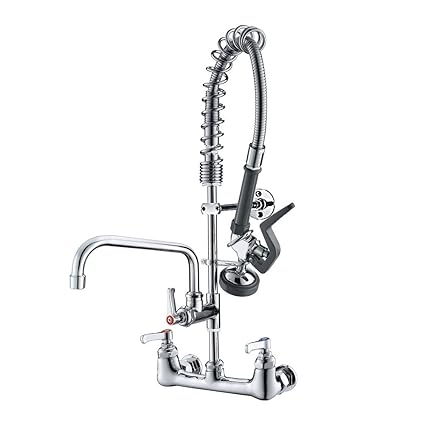Restaurants have proverbially high staff turnover, and are almost always short-staffed in the kitchen, so losing staff-hours to injury is the last thing you need. Unfortunately cooks are especially prone to lost-time injuries such as sprains, cuts and burns, because the restaurant kitchen is a hazard-filled workplace. Recognizing those hazards and taking steps to minimize them is your obligation as the boss, but it's also the smart way to operate. Slippery or Uneven Floors Restaurant floors are often slick with oil or water, and in older kitchens the floors themselves may be uneven. All of these things can lead to employees slipping or falling, which is extremely dangerous when you're working with sharp blades and hot implements. You can install non-slip flooring materials and mats to make the floors safer, and train your employees to clean the floors immediately after a spill.
Manual Handling In Commercial Kitchens
When they need to transport large quantities of hot liquids or used oil, provide safe transport methods - pots or sturdy buckets with well-fitting lids for the liquids, and carts to wheel them - rather than requiring employees to carry them. Non-skid footwear should also be mandatory in your kitchen, and it can help a lot. Floors that are structurally uneven pose a tripping hazard, but redesigning them may not be a practical option. Instead, install a small ramp over the uneven part of the floor to make a smooth transition or simply paint the uneven part of the floor with brightly colored paint to remind your staff about the danger of tripping. Dangerous Machinery and Equipment Commercial kitchens are filled with equipment that's designed to cut, chop or sear foods, and they'll do the same to an unwary line cook. The potential for accidents is huge, so it's important to train your staff to use equipment safely. Make sure kitchen supervisors - who serve as role models for the other staff - always observe the best practices when using kitchen equipment.
Employees who use prep equipment with blades, such as mandolines and motorized slicers, should ideally wear cut-resistant gloves that cover their wrists and fit snugly. Warn employees of the hazards of not using the equipment's supplied safety guards, or of allowing loose clothing to get caught in machinery. Keep safety manuals for kitchen equipment in a designated place so that employees can refer to them if they have any questions or concerns. Autocad training pdf. Post signs to remind workers of hazards such as 'Unplug machine before cleaning blades.' Heavy Lifting Sprains and strains can result from heavy lifting in the kitchen, and that leads to injuries.

Make back belts available to our employees on delivery or inventory days, to help reduce the risks. Train employees to pull or wheel the load as close as possible to them before lifting. Teach them to keep their heads up, backs straight and lift the load with their leg muscles. When putting items down, they should use their leg muscles as they squat - not their backs. Make dollies or hand trucks available whenever possible.
Crowded Workspace A cramped and crowded work area increases the risk of injury or accidents from all sources. Always make sure that walkways are clear and surfaces are clutter-free. Empty boxes and containers should be removed as soon as possible, and you should try to organize the work flow to space your cooks evenly throughout the kitchen. Burn and Chemical Hazards Restaurant kitchens are packed with hot surfaces, hot liquids and oils, and hot foods that spatter their surrounding area. Long-sleeved chef jackets are the industry standard for a reason, and cooks in high-splatter areas should wear bib aprons as well.
Be sure your cooks have safe work habits, and plenty of hot pads, side towels or heatproof gloves for handling hot pans. Chemicals, in the form of cleaning supplies and sanitizers, present another hazard. Your supplier will provide data safety sheets for all of your chemicals, and will usually offer periodic training for your staff as well. Your in-kitchen first aid kit should include everything you need to treat burns and cuts, as well as an eye-washing station in case your cooks are splashed with cleaning chemicals.

Food Hazards Food safety is another notable kitchen hazard, one that poses a risk to your customers and - in a worst-case scenario - to your business itself, Cross-contamination between high-risk and low-risk foods is a common danger, often caused by using the same equipment or prep surfaces without cleaning and disinfecting them between tasks. Improper thawing of frozen foods, or improper storage and reheating of prepared foods, are also common mistakes. Hot foods should always be held at a temperature of 140 degrees Fahrenheit or higher, and cold foods at 40 degrees or lower, to limit bacterial growth. Training your staff on food safety, closely monitoring temperatures, and enforcing good hand-washing habits, will go a long way to preventing any unfortunate incidents.

Post informational signs in restrooms and next to food prep areas, as reminders.